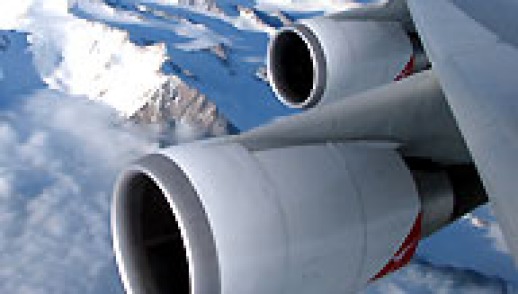With an Airbus A380 added to the route, more people are on board to see Antarctica, writes Chris Johnston.
A new era in Antarctica sightseeing began this year with the Qantas Airbus A380 "superjumbo" flying the route from Melbourne and Sydney.
The enormous aircraft - holding 450 passengers on two levels - flew a New Year's Eve sightseeing flight, leaving Melbourne (via Sydney) at 6.10pm and returning about 13 hours later. The next A380 Antarctica flight is on January 24 from Sydney over the South Pole. A Boeing 747 flight flies from Melbourne to the edge of Antarctica on February 14.

The flights are run by Croydon Travel's Antarctica Sightseeing Flights, which has been in the business since 1994, chartering aircraft from Qantas. Prices range from $999 in economy to more than $6000 in first class. Seats in eight classes are sold and those with a window are asked to be generous in sharing their views. Airline meals are served and alcohol is available. No passports are required (although photo ID is) despite the flight being deemed international.
The Antarctica flights travel over Tasmania and the Southern Ocean before skirting the edge of the Antarctic continent's coastal cliffs near the French research base at Dumont d'Urville, continuing inland in figure-of-eight patterns over glaciers. The exact route depends on the weather and visibility. The travel company says it has 19 approved flight paths, meaning the pilot can change route depending on conditions.
Australian Antarctic Division glaciologist Ian Allison goes on most of the flights to act as a commentator and to tell passengers what they are seeing out the window. He's been doing so for 12 years and has worked on the ice since 1969. He knows it's a party plane and that detailed science about the continent would go over people's heads but his outlook is simple: "If a few people do this and get inspired to want to preserve Antarctica and get inspired about our global environment and the amazing world we live in then that's fine by me."
He says even a brief look at the edge of Antarctica has the capacity to shift perspectives. "You can see these extraordinary glaciers which are rivers of ice but if you see them as river and the continent as a land mass you can begin to understand how it all works," he says. "Seeing Antarctica reinforces the idea that we are one globe and one environment."
Air New Zealand and Qantas began offering sightseeing flights over the Antarctic in February 1977. But after an Air New Zealand flight crashed into Mount Erebus in 1979 - killing all 257 people on board - both airlines stopped the flights. Qantas started again in 1994. Air New Zealand has not.
Flights only take off in summer. "It is the brief period of the year that it [Antarctica] has almost continuous sunlight, and views which stretch forever," Croydon Travel Antarctica Sightseeing Flight's managing director Phil Asker says. "Antarctica is the world's coldest, driest, windiest and most remote territory and the last great wilderness area."
Chris Johnston and Penny Stephens flew courtesy of Croydon Travel Antarctica Flights.